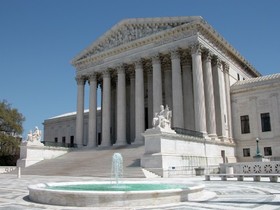One of the few cases I was following this year on the Supreme Court docket was Safford United School District v. Redding, a case out of Arizona where a 13 year old girl was search-stripped by school officials because of a "tip" that she had some ibuprofin. (She didn't, as it turned out).
I sketched the full details out in a post last April, including these details:
Ms. Redding, a model student, had never been in trouble with the law and never been so much as called to the principal's office. The other student who provided the "tip" to school officials was a former friend of Ms. Redding (the two had drifted apart — the friend had fallen in with the goth crowd, while Ms. Redding was one of the goody-two-shoes).
The strip search traumatized Ms. Redding to the point where she eventually changed schools (she is now a freshman in college).
I also covered the Court's demeanor at oral argument. It looked like it was heavily split on the counterveiling issues of privacy, and constitutional searches.
So you can imagine my surprise when the opinion (PDF) came out this morning. By a vote of 8-1, the Court ruled that the search was unconstitutional. Not even close.
(The dissenting judge was Justice Thomas. He has always taken the rather absurd opinion that the U.S. Constitution does not apply to state public schools, a rather crazy position which the 14th Amendment makes mincemeat of. I mean, even Scalia can't swallow that one.)
(The court also ruled, 7-2, that the school officials cannot be held liable, since the Fourth Amendment ruing was not "clearly established" at the actual time of the search. Ginsberg and Stevens dissented, arguing that controlling precedent had already established that strip-searching was unconstitutional).
The court reasoned:
Had Savana been suspected of having illegal drugs that could have posed a far greater danger to herself and other students, the strip search, too, might have been justified, the majority said, in an opinion by Justice David H. Souter.
“In sum, what was missing from the suspected facts that pointed to Savana was any indication of danger to the students from the power of the drugs or their quantity, and any reason to suppose that Savana was carrying pills in her underwear,” the court said. “We think that the combination of these deficiencies was fatal to finding the search reasonable.”
The ruling is significant because it comes at the end of a long line of SCOTUS opinions allowing student searches (locker searches, etc.). For a while there, it began to look like there was no zone of privacy for students at all. Well, apparently, we now have a line — you can't search their underwear or bodily cavities.
Well, you can, but you have to have some solid suspicion — something more than a hunch or a student tip — to justify the strip-searching of public school students. And the contraband has to be something more dangerous or potentially harmful than ibuprofin.
The other constitutional rule expressed in the opinion — searches of public school students’ backpacks, notebooks, other belongings, outer clothing, and pockets are generally allowed if they are based on “reasonable suspicion” — remains as it has for a quarter-century, but with a small amount of refinement, the exact scope of which is not quite clear.

